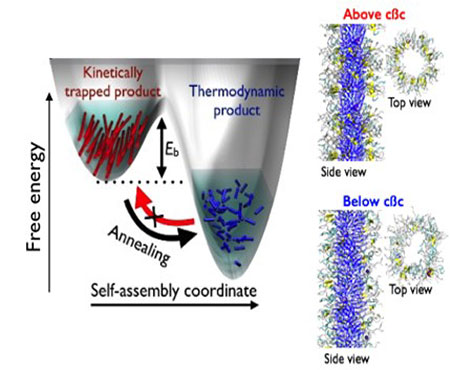Energy Landscapes and Functions of Self-Assembling Peptide Amphiphile Nanofibers
January 18, 2016
Scientific Achievement
The preparative pathway of self-assembled supramolecular systems can determine their final position in their energy landscape, thereby changing their properties as soft materials.

The energy landscape of peptide amphiphile self-assembly. Short fibers are thermo-dynamically favored, but long fibers can be accessed with another preparative pathway. Computer simulations show differences in molecular packing.
Significance and Impact
In biology, proteins can fold and misfold into numerous thermo-dynamic products, often compromising their functions. This research reports a similar link between energy landscapes and functions in synthetic materials.
Research Details
- Two local minima in the energy landscape of peptide amphiphiles were identified, one thermodynamically favored and one kinetically trapped.
- Each minimum can be accessed by selecting a preparative pathway.
- Kinetic trapping results from the ability of β-sheet secondary structure to lock molecules in thermodynamically unfavorable configurations.
Energy Landscapes and Functions of Supramolecular Systems
Tantakitti, F., Boekhoven, J., Wang, X., Kazantsev, R.V., Yu, T., Li, J., Zhuang, E., Zandi, R., Ortony, J. H., Newcomb, C.J., Palmer, L. C., Shekhawat, G. S., Olvera de la Cruz, M., Schatz, G.C., Stupp, S.I.
Nat. Mater. 15, 2016, 469–476.
Work performed at Northwestern University
